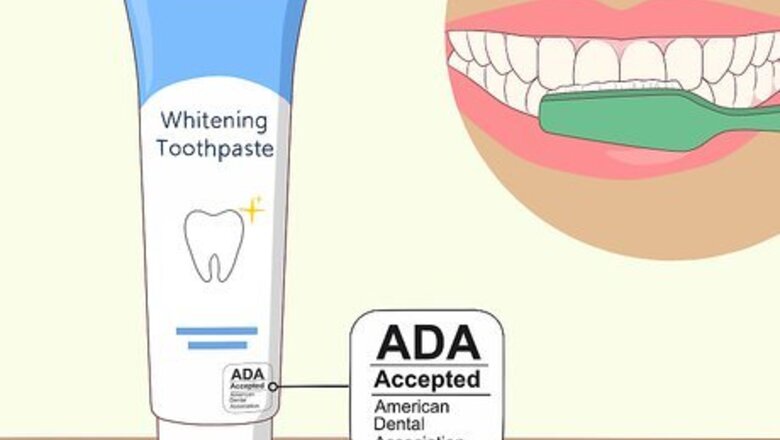
views
Whitening toothpaste
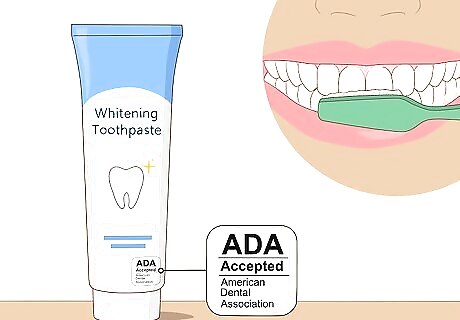
Using a whitening toothpaste daily can get rid of surface stains. Look for a toothpaste that has the American Dental Association (ADA) Seal of Acceptance to ensure that it’s safe to use. Use the toothpaste each time you brush your teeth, or at least twice per day. After 2–6 weeks, you’ll notice some of the stains on the surface of your teeth disappear. Whitening toothpastes don’t penetrate past the surface of your teeth, so it will not work for deep stains or discoloration. Check for an ingredient called “blue covarine” on the packaging. Blue covarine adheres to the surface of your teeth so they don’t look as discolored. Since whitening toothpastes have mild abrasives or hydrogen peroxide as their whitening agents, your teeth may feel more sensitive.
Whitening strips
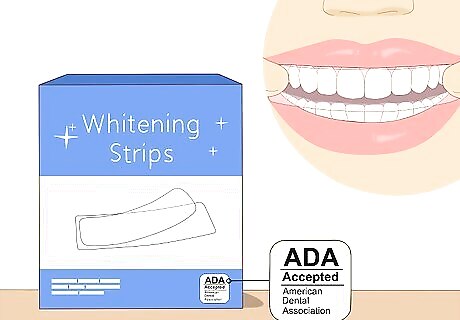
Strips have hydrogen peroxide that penetrate past your enamel’s surface. Choose whitening strips that have the ADA Seal of Acceptance so you know they won’t damage your teeth. Peel the backing off of the strip and press it onto your front teeth. Wrap the strips around your teeth so they stay in place. Keep the strips on for 30 minutes before removing them. Use the strips twice a day for about 2 weeks to see results. Since you leave the whitening strips on for a longer time, you’re more likely to get sensitive teeth. Always follow the directions on the specific brand of whitening strips you buy since they may be different.
Whitening trays
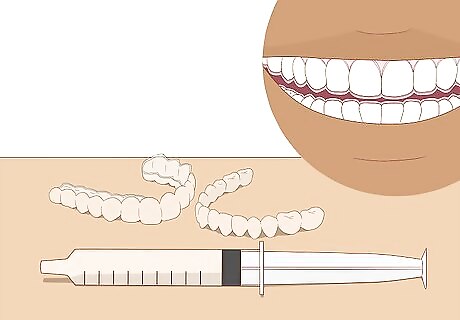
Trays are molded to your teeth so they’re more comfortable. Spread the bleaching agent, which is usually carbamide peroxide, inside of the trays and press them onto your teeth. Depending on the trays you’re using, you may wear them at night while you sleep or keep them in for 2–4 hours each day while you’re awake. After about 3–6 weeks, your teeth will look a shade or two lighter. You can buy whitening trays over-the-counter or get custom trays from your dentist. Whitening trays are thin so you’ll still be able to talk and work while you’re wearing them.
Whitening rinse
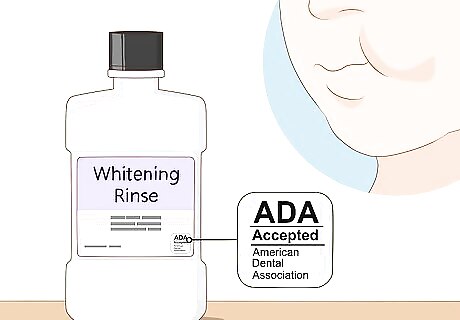
Whitening rinses are perfect for a quick way to clean surface stains. Look for a commercial rinse that has hydrogen peroxide and the ADA Seal of Acceptance. Pour the recommended amount into your mouth and swish it vigorously for about 60 seconds. Keep swishing your rinse twice a day for about 3 months to notice a visible difference in your smile. Avoid using straight hydrogen peroxide as a rinse since it could irritate your gums, tongue, or throat.
Whitening pens
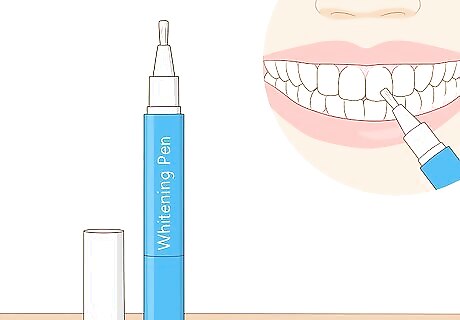
Pens with https://www.amazon.com/s?k=whitening+pens&crid=1B7UPXMIA58Z&sprefix=whitening+pens%2Caps%2C76&ref=nb_sb_noss_1&tag=wikihow88019-20 whitening gel] work best after you eat foods that stain your teeth. After enjoying a food or beverage that discolors your teeth, take the cap off of the whitening pen and dry your teeth with a napkin or tissue. Apply the hydrogen peroxide gel directly to your teeth. Keep your mouth open for 10–15 minutes so the gel can dry on your teeth. After that, brush your teeth to remove the gel. You may not notice immediate results, but the pen will prevent new stains from forming. Whitening pens are usually meant for your front teeth only since it can be hard to reach your back teeth. Plus, you normally don’t see your back teeth when you smile so you may not need to whiten them.
Baking soda
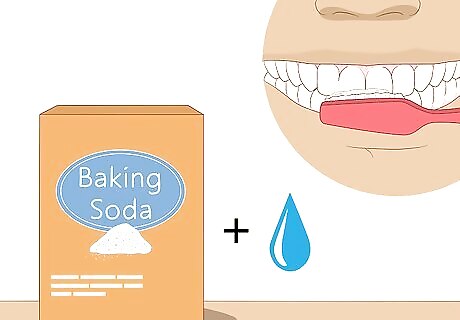
Baking soda is slightly abrasive, so it helps you get rid of discoloration. Put some baking soda on your toothbrush and wet it to form a paste. Gently brush your teeth as you normally would to spread the baking soda evenly over the surface. Be sure to rinse all the baking soda out of your mouth when you’re finished. Use baking soda 2 times every day for about 12 weeks so your teeth look lighter. Be sure to still brush your teeth with regular toothpaste to kill bacteria and prevent gingivitis. You can also get toothpaste that contains baking soda to whiten your teeth while you clean them.
Pineapple

Chew pineapple to release bromelain, an enzyme that lightens stains. You can incorporate pineapple into any meal you want to help your teeth. Chew the pineapple thoroughly to help spread the enzyme and produce saliva, which can help remove food particles that might cause additional staining. Very few studies have been done on pineapple’s effects on whitening teeth, so it may not be the most effective. If you keep pineapple on your teeth for a prolonged time, it could make them more sensitive and wear away your enamel.
Dairy products
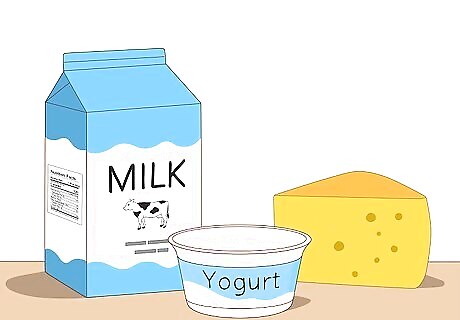
Lactic acid in dairy can help protect your teeth from discoloring even more. Since the lactic acid binds to your teeth, dairy foods like yogurt, milk, and hard cheeses all prevent additional stains. When you’re enjoying food that could stain your teeth, such as tea, mix it with milk or eat a dairy product right before so your teeth stay protected.
Professional whitening
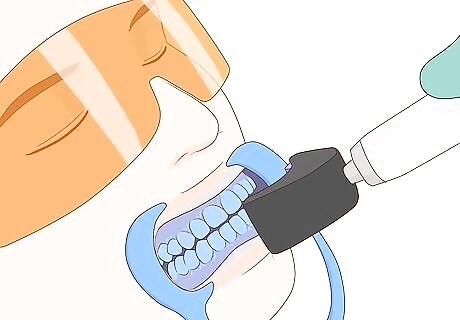
Your dentist has the best treatment, but makes your teeth more sensitive. Talk to your dentist to see if they have any bleaching or whitening procedures you can try. Your dentist will usually apply a strong peroxide to your teeth and use special blue lights to whiten your teeth within an hour. You could also be given at-home treatments to follow instead. However, since the chemicals your dentist uses are much more potent, they might increase the sensitivity of your teeth. Dental insurance usually doesn’t cover the cost of tooth whitening since it’s a cosmetic procedure. Follow all of your dentist’s instructions before and after you get your teeth professionally whitened.
Dental hygiene
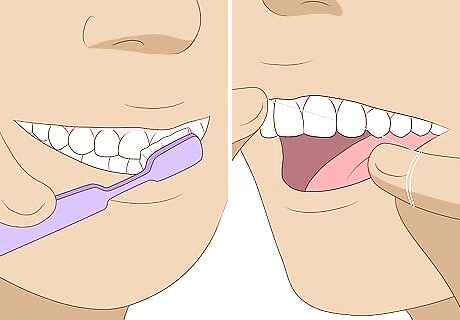
A daily dental care routine prevents new stains from developing. Be sure to brush your teeth at least twice a day for 2 minutes at a time. In addition to that, be sure to floss at least once a day to get rid of food particles that can cause cavities. As long as you keep your teeth clean regularly, you’ll maintain a healthy and bright smile. Visit your dentist once or twice every year for a check-up and cleaning.















Comments
0 comment